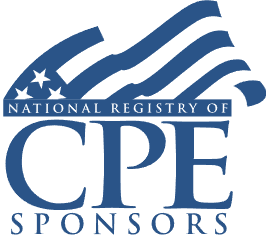Tax Reporting of IRA Beneficiary Trusts: Conduit vs. Accumulation and RMD Calculations
Designated Beneficiaries, DNI Calculations, Disqualifying Terms, Form 1041 Compliance

Course Details
- smart_display Format
On-Demand
- signal_cellular_alt Difficulty Level
Intermediate
- work Practice Area
Tax Preparer
- event Date
Wednesday, September 27, 2017
- schedule Time
1:00 PM E.T.
- timer Program Length
110 minutes
-
BARBRI is a NASBA CPE sponsor and this 110-minute webinar is accredited for 2.0 CPE credits.
-
BARBRI is an IRS-approved continuing education provider offering certified courses for Enrolled Agents (EA) and Tax Return Preparers (RTRP).
-
Live Online
On Demand
This course will provide tax advisers to fiduciaries with detailed and practical guidance on the tax reporting complexities of trusts designated as IRA beneficiaries. The panel will thoroughly discuss the rules for measuring life expectancy for purposes of required minimum distributions (RMDs) and distributable net income (DNI) when using a look-through trust. The webinar will also address specific reporting issues on Forms 1041, 8606 and 5498.
Description
The use of a trust as an IRA beneficiary is an increasingly popular tool for both tax deferral and asset protection. These “see-through” trusts can provide valuable flexibility in a comprehensive estate plan but also carry income tax consequences and strict IRS qualification requirements.
Tax advisers and compliance professionals must understand the unique characteristics of IRA beneficiary trusts to avoid costly tax compliance mistakes.
IRA beneficiary trusts generally come in two types: “conduit trusts” and “accumulation trusts.” Conduit trusts have specific requirements for calculating required minimum distributions over the lifetime of specified beneficiaries. Accumulation trusts generally provide greater “stretch” treatment but are more complex and may result in less favorable income tax treatment.
Fiduciaries and their tax advisers must be able to identify and apply the RMD rules by identifying the designated beneficiary. RMD amounts are measured over the life expectancy of the oldest beneficiary at the time of the IRA owner/trust settlor’s death.
RMD calculations are more complex than would appear, and certain trust provisions (such as powers of appointment) can serve to deny “see-through” treatment.
Listen as our experienced panel provides detailed guidance on the operation and tax reporting of see-through IRA beneficiary trusts.
Outline
- Trusts as beneficiaries of IRA
- “Stretch” treatment of RMDs within a look-through trust
- Conduit vs. accumulation trust
- DNI impact
- Tax reporting challenges of IRA beneficiary trusts
Benefits
The panel will discuss these and other important topics:
- How to recognize a valid IRA beneficiary trust
- How to distinguish between a conduit trust and an accumulation trust
- Identifying designated beneficiaries of the see-through trust for purposes of calculating RMD amounts based on life expectancy of “oldest beneficiary”
- Recognizing terms in the trust document that can disqualify an IRA beneficiary trust from “stretch” treatment
- What issues does naming a QTIP as beneficiary of the IRA trust create and how to resolve them
NASBA Details
Learning Objectives
After completing this course, you will be able to:
- Distinguish between a conduit trust and an accumulation trust
- Discern the benefits of “stretch” treatments in calculating RMDs
- Identify the challenges of ascertaining beneficiaries of the IRA beneficiary trust for purposes of RMD calculations
- Determine specific reporting requirements and challenges of calculating income in an IRA beneficiary trust
- Recognize trust terms that may invalidate an IRA beneficiary trust from “stretch” treatment of the accounts used to fund the trust
- Field of Study: Taxes
- Level of Knowledge: Intermediate
- Advance Preparation: None
- Teaching Method: Seminar/Lecture
- Delivery Method: Group-Internet (via computer)
- Attendance Monitoring Method: Attendance is monitored electronically via a participant's PIN and through a series of attendance verification prompts displayed throughout the program
- Prerequisite: Three years+ business, law or public firm experience at mid-level within the organization, preparing complex trust vehicles for estate planning; supervisory authority over other preparers/accountants. Specific knowledge and understanding of Individual Retirement Accounts within an estate planning structure, IRA beneficiary trusts, and IRS regulations addressing requirements for trusts; familiarity with conduit, accumulation and RMD calculations .

Strafford Publications, Inc. is registered with the National Association of State Boards of Accountancy (NASBA) as a sponsor of continuing professional education on the National Registry of CPE Sponsors. State boards of Accountancy have final authority on the acceptance of individual courses for CPE Credits. Complaints regarding registered sponsons may be submitted to NASBA through its website: www.nasbaregistry.org.

Strafford is an IRS-approved continuing education provider offering certified courses for Enrolled Agents (EA) and Tax Return Preparers (RTRP).
Unlimited access to premium CLE courses:
- Annual access
- Available live and on-demand
- Best for attorneys and legal professionals
Unlimited access to premium CPE courses.:
- Annual access
- Available live and on-demand
- Best for CPAs and tax professionals
Unlimited access to premium CLE, CPE, Professional Skills and Practice-Ready courses.:
- Annual access
- Available live and on-demand
- Best for legal, accounting, and tax professionals
Unlimited access to Professional Skills and Practice-Ready courses:
- Annual access
- Available on-demand
- Best for new attorneys
Related Courses
Recommended Resources
How CPE Can Bridge the Gap Between What You Know and What You Need to Know
- Career Advancement
